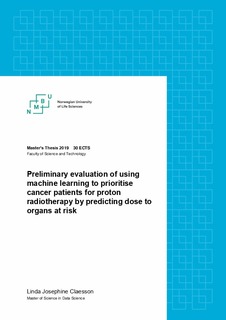| dc.contributor.advisor | Futsæther, Cecilia Marie | |
| dc.contributor.advisor | Tomic, Oliver | |
| dc.contributor.author | Claesson, Linda Josephine | |
| dc.coverage.spatial | Norway | nb_NO |
| dc.date.accessioned | 2019-07-17T09:11:33Z | |
| dc.date.available | 2019-07-17T09:11:33Z | |
| dc.date.issued | 2019 | |
| dc.identifier.uri | http://hdl.handle.net/11250/2605602 | |
| dc.description.abstract | The investment in proton radiation therapy raises the question of how cancer patients
should be prioritised for this treatment method. A large advantage to proton
therapy is that one can minimise the radiation received by organs at risk. Machine
learning might be used for predicting the impact of organs for different radiotherapy
methods. Thus, machine learning could be a helpful tool in the prioritisation
process.
In this thesis, spatial features were extracted from medical images of head and neck
cancer patients. These features were used for analysis of photon dose distributions
of target volumes and organs at risk. Additionally, correlations between features
were investigated. It was confirmed that the distance between radiation target
volumes and organs at risk correlated with the dose received by the organs. Further,
the analysis contributed to an understanding of which spatial features were expected
to affect the dose given to organs at risk.
Within machine learning, both classification and regression algorithms were tested
for dose prediction by using the extracted spatial features. In addition, different
combinations of algorithms and features were evaluated. The algorithms with the
highest accuracy scores were Logistic Regression and Random Forest.
However, the machine learning models either overfitted or underfitted. Thus, other
features and machine learning methods should be tested. A possibility for future
work is to use deep learning for constructing spatial features and prioritising patients
for proton therapy. | nb_NO |
| dc.language.iso | eng | nb_NO |
| dc.publisher | Norwegian University of Life Sciences, Ås | nb_NO |
| dc.rights | Attribution-NonCommercial-NoDerivatives 4.0 Internasjonal | * |
| dc.rights.uri | http://creativecommons.org/licenses/by-nc-nd/4.0/deed.no | * |
| dc.subject | Feature extraction | nb_NO |
| dc.subject | Photon radiotherapy | nb_NO |
| dc.title | Preliminary evaluation of using machine learning to prioritise cancer patients for proton radiotherapy by predicting dose to organs at risk | nb_NO |
| dc.type | Master thesis | nb_NO |
| dc.description.version | submittedVersion | nb_NO |
| dc.source.pagenumber | 106 | nb_NO |
| dc.description.localcode | M-MF | nb_NO |

